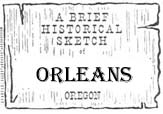|
|
Orleans |
|
|
Of ghost towns Orleans is the oldest — with the shortest life. Orleans Precinct was organized about 1849, polling 27 votes that year. The voting place was the village of Orleans, and prominent settlers in the precinct were John McCoy, Wm. McCoy and Dr. Haley, who arrived about 1846 (174). Isaac Moore was proprietor of the village. In 1848 he staked a 322 acre claim north of the homesteads of the McCoy and Haley families. Across from him, on the opposite bank of the Willamette River, rose the new town of Marysville, laid out by Joseph C. Avery. Ambitious, Moore also started a town in 1851, naming it Orleans. He built a terry and obtained a license. Little is known about the first years of the town's existence. It is surmised, because of casual mention and obscure records, that in the middle 1850’s Isaac Moore sold a number of lots, and that the town was laid out in at least 15 blocks and had a "Main Street”. It seems to have thrived on the farming in its immediate neighborhood, on the ferry, and through trading with the surrounding country. By 1860 it was quite well known up and down the river and it began to harbor aspiration to outgrow Corvallis. Then came catastrophe. During the flood in the Willamette in 1861—62 it was swept away. The Corvallis Times of Jan. 31, 1903, tells about it (178): COMPARING FLOOD CONDITIONS OF 1902-02 WITH THOSE OF 1861-2. “On last Sunday night might have been seen an occasional lantern flicker on the opposite side of the river.. “On a Sunday night in the winter of ‘61—’82
it was otherwise. At that time on the east side of the river there was a
village of some pretensions to which had been given the name of Orleans
by the founder, Isaac Moore. Among its best known inhabitants were Isaac
Moore, Mr. and Mrs. Philip Phile, Mr. & Mrs. Joseph Gerhard, Mr.
& Mrs. Morgan Lillard, and a little beyond these resided the latter’s
father-in-law, Charles Mulkey. David Millhollen and family resided in
the house now owned and occupied by Mr. Butler, situated near the
Government jetty. All that Sunday night there was a shouting of men,
cries of distress from women, and firing of guns for help as the mad
waters created havoc in the town of Orleans and elsewhere. That was more
than forty years ago, but those now living who participated in the
scenes of that night in the little village speak of them with awe and
deep concern. They say that it was an awful time. Stock of every
description was all about, struggling for life in the angry flood, but
there was no time to waste on them. There were too many lives at stake.
The rush of waters came suddenly and unexpected, and none had taken any
precaution to guard against the danger. The first alarm was given by
parties who were awakened by drift logs striking against their houses.
Those in the greatest danger were moved to safer places in the village.
Joseph Gerhard and John Summer conveyed their wives, each with two small
children, to the former’s hay loft where they remained until the next
day. In the meantime these two gentlemen, Philip Phile, and others sore
kept busy with boats rescuing others. “William Lewis and wife were young persons who occupied a small dwelling in the village, and they were determined to remain in their little home as long as possible, hoping and praying that the waters would recede. Before they took leave of the house, however, the wife was taken violently ill and, as the rising waters dampened the straw mattress on which she lay, a baby girl was born to the family. The necessity of her removal was imperative and the mother and the child and the bed were placed in the skiff. They were rowed to the residence of Mr. Moore and placed on the second floor through an upper story window. When day finally dawned mother and child were brought to Corvallis where they were able to secure proper attention. As soon as possible after daylight all the women and children of Orleans were conveyed to the west side of the river. "During the night and following morning several houses were washed away on the east side, among which was the one owned by Mr. Summer, whose family took refuge in the hay loft with Mrs. Gerard; one belonging to Philip Phile which was afterward hauled back and now forms a portion of the beach residence at the ferry. A building which had been built for a brewery was also carried away. One result of this flood was that it killed the aspirations of Orleans to become a rival of the west-side town of Corvallis.” In another column (178) there is this notice: “The house of Jeptha Parrott on the site from which Phile’s house was carried away in 1861—62 was washed away with two acres of land in 1902—03.” Nothing worth mentioning is left of the ancient aspiring town of Orleans. The precinct remains. The U. S. Census for 1870 gives it 380 inhabitants. In 1880 it was given 466 people, in 1940, 811.
|
Orleans Quick Facts Location: Twp 11S, Rge 5W, Sect 36 Name Origin: Unknown. |
||
Town histories were
abstracted from: "History of Linn
County", Compiled by Workers of the Writer’s Program, Works Progress
Administration, 1941. See bibliography
for above-cited references. All photos from the collection of Lisa L.
Jones, unless otherwise noted. Lisa
L. Jones contributed and is solely responsible for the content of these
pages. Copyright 2001.
